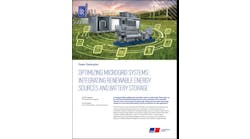Steve Winkelman, Center for Clean Air Policy
The federal government’s new climate assessment should serve as a wake-up call that spurs policymakers to promote energy efficiency and microgrid development.
The report, based on information from more than 300 experts, summarizes scientific research about the very real threat of climate change, bringing home its point with many recent examples of the effects of climate change.
“It is important that these findings and response options be shared broadly to inform citizens and communities across our nation,” said the report. “Climate change presents a major challenge for society. This report advances our understanding of that challenge and the need for the American people to prepare for and respond to its far-reaching implications.”
Helping Policymakers Understand
“The report provides a nice summary in the most graphically smart format to help people in different regions of the country, especially policymakers, understand not only what’s projected to come in terms of heat and severe weather but what the recent trends have been,” said Steve Winkelman, director of the Center for Clean Air Policy’s adaptation and transportation programs. “It is hopefully an entrée into a variety of resources for the federal government to do assessment and planning and increase resiliency and response.”
Energy efficiency and microgrids play an important role in helping the US cope with climate change. For example, said Winkelman, buildings with better insulation and tight envelopes will be more secure. “When the power is out, they will maintain their temperatures. A better insulated building will help get people through a power outage.”
Onsite generation and microgrid options provide an opportunity to provide both efficiency and renewable energy – which help stem global warming – and protect people from power outages, he added.
A CCAP report, “Green Resilience: Climate Adaptation and Mitigation Synergies” quotes Johnson Controls as calling for grid-responsive, energy efficient, net positive and resilient buildings.
“Microgrids, supported by distributed energy generation, are a potential solution, as they allow decentralized energy distribution at a community scale,” said the CCAP report.
The report identifies potential pilot projects in Washington, D.C. and Boston that would involve adding resilience measures to green building projects, codes and policies. What’s more it calls for installing combined heat and power in hospital and university campuses as a first step toward microgrids.
The CCAP report also suggests that FERC modify policies to facilitate microgrids.
Read the CCAP report here: Green Resilience Report From CCAP
The bottom line: The federal government’s new climate assessment doesn’t pussy-foot around about the very real threat of global warming. And that should be good news for the energy efficiency industry, which provides multiple benefits: Not only does efficiency reduce the greenhouse gases that cause global warming, it can keep buildings comfortable longer during outages. And microgrids take this idea one step further, often providing emission-free alternative energy, plus an off-grid solution.
As Winkelman said, “I’m impressed with the administration putting out such strong, scientifically-backed work.” And it’s also impressive that the administration called for action in what hopefully will be a politically palatable manner.
What’s your take on energy efficiency, microgrids and climate change? Join the conversation on our Microgrid Knowledge LinkedIn Group.







